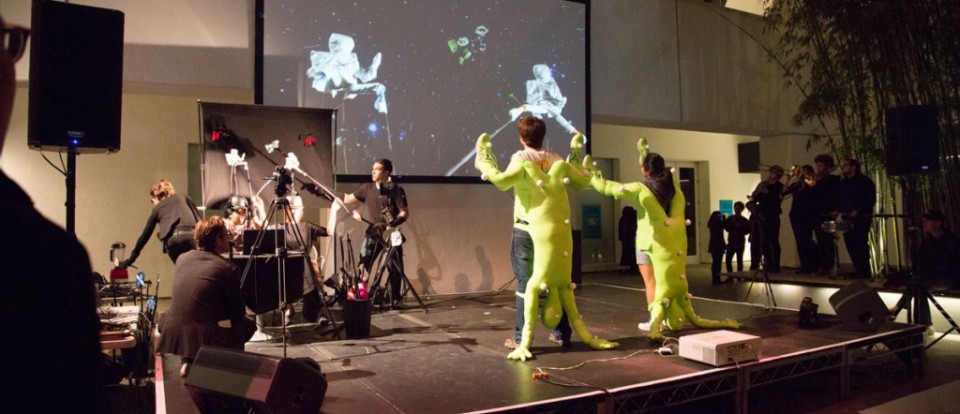
Meet Isla Hansen: UCLA Game Lab Artist in Residence
Posted on December 21st, 2015
by
David O' Grady
Artist Isla Hansen strives to create interactive media works that are as inviting as possible—even irresistible, as one of her pieces at November’s UCLA Game Art Festival proved. Titled Long Reliever, the sculpture uses a Nintendo Wiimote affixed to a moving armature that replicates the rudimentary motions of an endless game of Wii baseball. Essentially, Hansen built a machine to play itself. But that didn’t stop festival attendees from trying to get involved.
“People wanted to play that like a game, but it wasn’t that kind of work,” Hansen said. “They eventually broke it!”
Such compelling approachability is a hallmark of Hansen’s work, which mixes interactive technologies with the participant’s own body to re-enact forms of popular media, play, and industrial systems of production. Hansen, a New York-based artist, received her MFA in 2015 at Carnegie Mellon University and was awarded a 2015 Dedalus Foundation fellowship. She has spent this past fall in the UCLA Game Lab as an Artist in Residence, a program that promotes in-depth exchanges between UCLA-based game-makers and visiting artists.
Hansen sat down at a campus café for an interview, delayed by fixing a flat tire on her bicycle—an example of the technological dependency that brings people both pleasure and frustration, a tension Hansen’s projects explore.
“Every piece of technology is developed in relation to us,” Hansen noted. “But there’s a myth, a narrative, about how well our relationship with technology is actually working. Technology’s narrative is about tracking us, fixing us, replacing our bodies. My work is a response to the conflation of technology and the body. I’m playfully trying to pick apart that narrative.”
Although Hansen’s art reveals our complex and confounding relationships with technology, she employs soft materials, bright colors and stagecraft wizardry to make her interactive works unthreatening, even enticing. Hansen credits her experience with interactive installations at children’s museums and science museums—in particular, her residency at the Children’s Museum of Pittsburgh—as highly influential in her user-friendly approach to art. “Watching children interact with installations is highly instructive for an interactive artist,” Hansen said. “I want to tap into this mode of playful viewing, in which audiences of any age can approach art and access it through tactile experience, humor, and spectacle.”
Hansen’s Rube Goldberg-like installations often transmute the commercial hype of new gadgets and devices into spectacles of technology to reveal the power—and problems—of technology as an embodied medium. One of her recent projects, The Lachrymator (2015), contemplates the relationship between the industries of filmmaking and food production, using the eye-irritating chemical released by chopped onions to explore how human physiological reactions—such as tears—can be “manufactured” by industrialized technology.
“I created this tyrannical, Ikea-store-inspired navigable space that compels people to move past a series of essentially bad, cinematic special effects—all while performers chop onions,” Hansen explained. “The installation critiques the clichéd mechanisms of narrative used by both Hollywood storytellers and now the food industry alike. In movies, it’s not the stories themselves that really make you cry—it’s the visual effects, the music, the construction of the medium that’s so manipulative. In my piece, what makes you cry as you watch the film is that I’ve just asked you to stick your face in a food processor filled with onions.”
It was while earning her MFA at Carnegie Mellon University that Hansen reached out to Eddo Stern, UCLA Game Lab director and DMA professor, to be on her thesis committee. Stern’s work explores the uneasy boundary between physical bodies and simulated worlds, tackling themes that resonate with Hansen’s preoccupations.
“After getting to know Isla and her work, I wanted to invite her to collaborate with us at the game lab,” Stern said. “The performative aspects and the critical humor in her pieces were a great fit for our lab and our annual festival in particular. It was wonderful to see the new works that she created for the festival stage.”
Hansen’s stage project Cos-Mo Cap Astrodome America typifies her de-constructed, technologically mediated, yet readily accessible approach. For this installation, performers on-stage donned motion-capture suits and used their arms to move their virtual astronaut legs through outer space as displayed on a giant screen projection. The satirical video introducing the game and the performance itself make at least one lesson about technology quite clear: whatever sense of transcendence technology can deliver—such as the feeling of walking in space—we also remain inexorably tethered to the bewildering burden of imperfect technologies.
Hansen enjoyed developing the project at the UCLA Game Lab, and she was very much at home during her tenure. “I feel like an outsider to games and the game industry,” Hansen said. “Knowing that Eddo ran the game lab put me at ease. Everyone here is wacky in the best sense—I walked into a roomful of people like me. And the festival was a great experience.”
Now concluding her residency at the lab, Hansen will return to Brooklyn to develop her next project: a performance piece involving a local woman’s basketball team. Hansen is planning a live event, replete with costumes, small orchestra and half-time performances in order to explore an allegory about nature versus technology, using a basketball game as the medium.
“I’m always trying to make something that can be experienced on two levels,” Hansen said. “Superficially, it’s something entertaining and visually stunning. But underneath the surface lies a critique of the very thing you think you’re enjoying. Ideally, that’s what my work is all about.”
